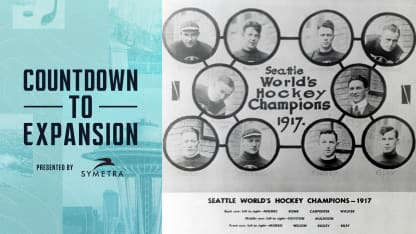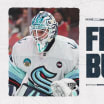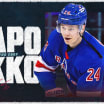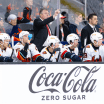The arrival of the Kraken for the 2021-22 regular season rounds out the NHL to 32 teams. That's a 533 percent jump for a league that sported only the "Original Six" teams when the Stanley Cup was awarded in 1967.
Here's a look at how the NHL was founded, expanded, downsized a bit, then doubled, doubled again, then grew even more to its current four eight-team divisions configuration.
6 Days Away: NHL Expansion's Historic Timeline
Founded in 1917, the world's most elite hockey league played 50 years with 10 or less teams. The 1960s, 1970s and 1990s changed all that for the bigger and better

By
NHL.com
Earliest Days: Seattle Wins Stanley Cup
The NHL was founded in November 1917 as a four-team league-two in Montreal, one in Toronto and one in Ottawa. Back then, the NHL champion played the winner of the Pacific Coast Hockey Association (PCHA), which included the Seattle Metropolitans, for the Stanley Cup.
As many Seattleites know, the Metropolitans won the Stanley Cup in March 1917-as the first American team ever-defeating the Montreal Canadiens (then in the National Hockey Association). The Metropolitans won the best-of-five series in four games, all played at the Seattle Ice Arena, which was built downtown in 1915. Forward Bernie Morris scored 14 of Seattle's 23 goals.
The Metropolitans reached the Stanley Cup Final in 1919, rematching with the Canadiens, now members of the NHL. All games of the series were again played at the Seattle Ice Arena with games alternating between the PCHA format (which included an extra skater in a "rover" position) and NHL rules. But the series was halted because of the Spanish Flu pandemic after the teams went 2-2 with one tie in five games.
The Metropolitans won Games 1 and 3 under PCHA rules; the Canadiens won Games 2 and 5 under NHL rules. The teams played to a scoreless tie in Game 4 under NHL rules. Since there was no win-loss outcome, Montreal successfully argued Game 5 should repeat as an NHL-rules contest.
The Game 4 goalie duel between Seattle's Hap Holmes and Montreal's George Vezina, both Hockey Hall of Famers, was called after two overtimes (the play-until-someone-wins format didn't exist then). A sellout crowd gave the teams a standing ovation as they left the ice.
But by the morning of April 1, hours before a sixth game that would have decided the Cup, 10 of the 13 players on Montreal's roster had come down with the highly contagious Spanish Flu. Montreal manager George Kennedy informed the Metropolitans his team would forfeit the Cup.
But his Seattle counterpart, Pete Muldoon, refused, saying he didn't want to win because of illness. The series ended 2-2-1. It's still the only Stanley Cup Final not played to a decision. Montreal defenseman Joe Hall died four days later.
Seattle made the Stanley Cup Final again in 1920 but lost to the NHL's first version of the Ottawa Senators in five games.
Heading to the USA
The NHL expanded into the United States in 1924, took sole control of the Stanley Cup in 1926 and grew to 10 teams by the mid-1930s. But the league began to lose members in the next few years.
By 1940, the NHL team count was to seven, and in 1942, the New York Americans ceased operations, reducing the NHL to the teams known today as the "Original Six": the Boston Bruins, Chicago Blackhawks, Detroit Red Wings, Montreal Canadiens, New York Rangers and Toronto Maple Leafs.
The Original Six stayed that way for the next 25 years, with NHL owners resisting numerous applications to expand. But by the mid-1960s, the major U.S. television networks had dropped the league and were threatening to televise games from the Western Hockey League (which had teams in several large West Coast cities, including Seattle).
Double the Fun
In 1965, the NHL announced that it would add six new teams, to begin play for the 1967-68 season. The price tag: $2 million each.
The six new teams-the Philadelphia Flyers, Pittsburgh Penguins, Minnesota North Stars, St. Louis Blues, California (later Oakland) Seals and Los Angeles Kings-gave the NHL much more of a claim to being a "national" league.
The newcomer franchises were placed in the "West Division," with the winner earning a trip to the Stanley Cup Final. The Blues came out of the West to reach the Cup Final in each of the first three seasons but didn't win a game in the final rounds against the East's Original Six.
Busy 1970s: Expanding, Competing with WHA
The NHL spent the first half of the 1970s adding teams every other year.For the 1970-71 season, the Buffalo Sabres and Vancouver Canucks entered the league, providing teams to two solid minor-league markets passed over during the 1967 expansion.
Two years later, the NHL entered the deep South for the first time with the Atlanta Flames. The league placed a second team in the New York area, the New York Islanders, playing in Uniondale, Long Island, about 20 miles from the Manhattan-based Rangers. Long Island was a hot hockey market, and the NHL wanted to make sure the upstart World Hockey Association, which also began play in 1972-73, didn't get a toehold there.
In 1974, the NHL added two more teams, the Washington Capitals (to play in Landover, MD outside D.C.) and the Kansas City Scouts. The NHL had become an 18-team league, with 12 of the teams less than a decade old.
By the mid-1970s, some of the early expansion teams were blossoming into powerhouses. Philadelphia's Flyers were the first expansion team to win the Cup in 1974 by defeating Boston in the Final, then repeated in 1975 by ousting Buffalo in the first all-expansion, post-1967 Final.
But there were more teams on the way.
Four from the WHA
The WHA made life miserable for the NHL during much of the 1970s, triggering an explosion in salaries that forced some teams to relocate. For the 1976-77 season, Kansas City moved to Denver (and then to New Jersey in 1982) and Oakland left the West Coast for Cleveland. Two years after that, the renamed Barons merged with the North Stars in Minnesota.
But in the summer of 1979, the upstart WHA threw in the proverbial towel, with the NHL absorbing four of its teams -- the Edmonton Oilers, New England (renamed Hartford) Whalers, Quebec Nordiques and Winnipeg Jets-for the 1979-80 season.
The WHA teams were allowed to keep a few of their players. Most notably, the Oilers retained a skinny center named Wayne Gretzky, who had signed as a 17-year-old and thus was never drafted by an NHL team.
All Gretzky did was set dozens of NHL scoring records and help the Oilers win the Cup four times in five years during the 1980s. The other three ex-WHA teams didn't fare as well: All relocated in the mid-1990s: Quebec to Denver, Winnipeg to Phoenix and Hartford to Raleigh, N.C.
Expansion Boom 2.0
The NHL began a second major surge of expansion when the San Jose Sharks joined the league for the 1991-92 season. They enjoyed much more success than their Bay Area predecessors, the Golden Seals.
The Tampa Bay Lightning and Ottawa Senators were added for the 1992-93 season, followed one year later by the Anaheim Mighty Ducks and Florida Panthers (based in Miami).
The Panthers were a stunning early success, advancing to the Stanley Cup Final in 1996, their third season, before being swept by the Colorado Avalanche (in their first season after relocating from Quebec).
The new teams kept coming. The NHL granted four conditional franchises in the summer of 1997. The Nashville Predators began play for the 1998-99 season.
The original Atlanta Flames moved to Calgary in 1981. The NHL awarded the southern hub city a second franchise, the Atlanta Thrashers in 1999.
The year 2000 brought the arrival of the Columbus Blue Jackets and Minnesota Wild (who replaced the North Stars in hockey-mad Minneapolis after the northern city's first NHL team relocated to Dallas as simply the Stars in 1993.
The six-team league of the 1960s was now 30 teams strong as the 21st century began.
Whew, take a moment. That's a lot of franchise creation and movement.
NHL took its own breather after adding nine teams in the 1990s. For the next 16 years, the only change in the 30-team league was the Thrashers' move to Winnipeg in 2011, a decade-and-a-half after the original Jets left for Phoenix.
Team No. 31 entered the NHL for the 2017-18 season when Vegas became the first sports franchise in a U.S. major professional league to be based in Las Vegas. To the amazement of NHL fans and media everywhere, Vegas made the Stanley Cup Playoffs and Cup Final in its first season against Washington, which subsequently won its first championship since entering the NHL 44 years earlier.
For schedule-makers, 31 is an odd number. The NHL was soon in the market for another team to balance things out.
On Dec. 4, 2018, the league's Board of Governors voted to award a franchise to Seattle Hockey Partners, giving the city its first pro hockey team since the demise of the Seattle Totems of the Western Hockey League in 1975.
Under the guidance of franchise CEO Tod Leiweke, Seattle hired former Carolina general manager Ron Francis as its GM on July 28, 2019.
A year later, the team announced on July 23, 2020, it would be known as the Seattle Kraken.
Almost another year after that, Dave Hakstol was named the Kraken's first head coach on June 24 last month.
The Kraken will stock its roster at the NHL Expansion Draft July 21 and the NHL Entry Draft™ July 23 and 24, and will play its home games at Climate Pledge Arena, which will open this fall to write a new chapter in hockey expansion history.


















